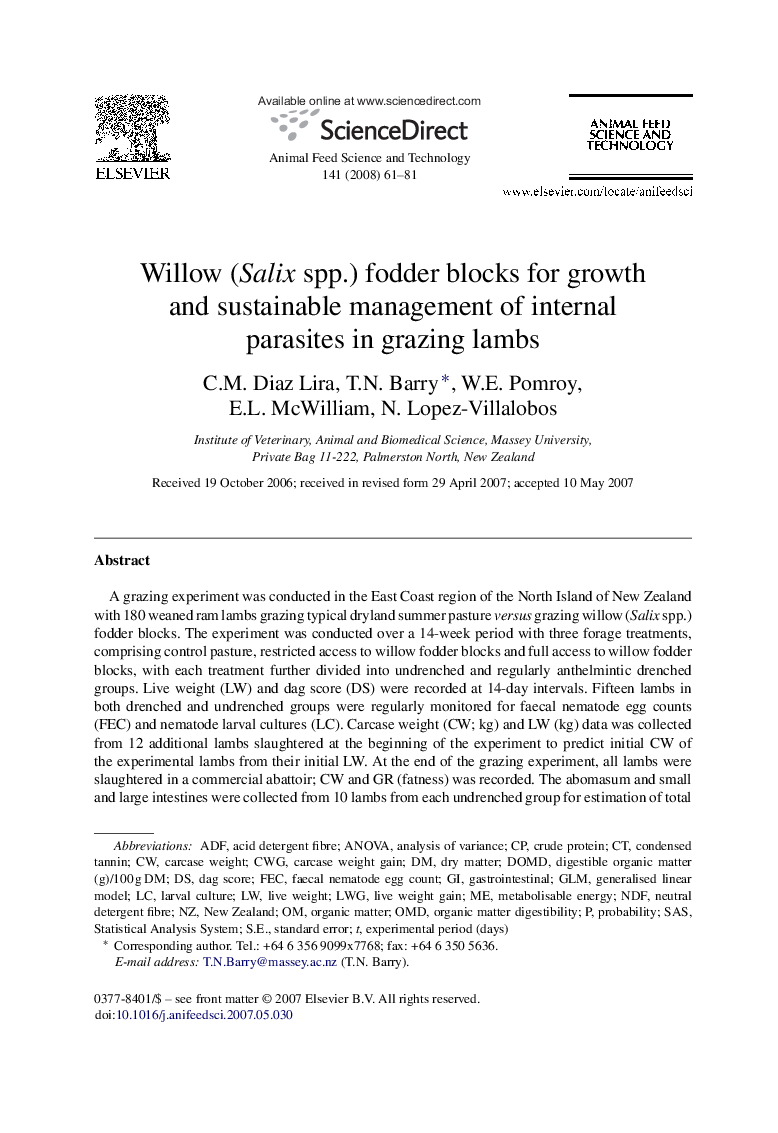| کد مقاله | کد نشریه | سال انتشار | مقاله انگلیسی | نسخه تمام متن |
|---|---|---|---|---|
| 2420678 | 1552474 | 2008 | 21 صفحه PDF | دانلود رایگان |

A grazing experiment was conducted in the East Coast region of the North Island of New Zealand with 180 weaned ram lambs grazing typical dryland summer pasture versus grazing willow (Salix spp.) fodder blocks. The experiment was conducted over a 14-week period with three forage treatments, comprising control pasture, restricted access to willow fodder blocks and full access to willow fodder blocks, with each treatment further divided into undrenched and regularly anthelmintic drenched groups. Live weight (LW) and dag score (DS) were recorded at 14-day intervals. Fifteen lambs in both drenched and undrenched groups were regularly monitored for faecal nematode egg counts (FEC) and nematode larval cultures (LC). Carcase weight (CW; kg) and LW (kg) data was collected from 12 additional lambs slaughtered at the beginning of the experiment to predict initial CW of the experimental lambs from their initial LW. At the end of the grazing experiment, all lambs were slaughtered in a commercial abattoir; CW and GR (fatness) was recorded. The abomasum and small and large intestines were collected from 10 lambs from each undrenched group for estimation of total worm nematode numbers. Organic matter digestibility (OMD; 0.65) and metabolisable energy (ME; 9.7 MJ/kg DM) content were similar for fodder block pasture and control pasture; the selected tree fodder had a higher OMD (0.71) and ME concentration (10.7 MJ/kg DM). Herbage condensed tannin (CT) concentration in willow fodder blocks was consistently higher than the trace CT levels detected in control pasture (14.5 g/kg DM versus 6.2 g/kg DM); tree fodder contained higher concentrations of CT (45.5 g/kg DM). Undrenched lambs grazing either control pasture or willow fodder blocks had lower LW gain (LWG) and CW gain (CWG) than lambs regularly drenched with anthelmintic (P<0.0001). Lambs grazing fodder blocks had consistently lower DS and carcase GR and undrenched lambs grazing fodder blocks had reduced worm burdens of economically important internal parasites compared with undrenched lambs grazing control pasture. Lamb growth rates were reduced by restricted access to willow fodder blocks (P<0.01), but not by full access. Undrenched lambs grazing fodder blocks with full access had similar LWG, final DS and carcase GR to regularly drenched lambs grazing control pasture (the conventional farming system), but had reduced rates of CWG. It was concluded that willow fodder blocks could have a place in integrated systems for the control of internal parasites in grazing lambs, leading to a reduction in anthelmintic drench use, but that this would probably result in lower CW relative to regularly drenched lambs.
Journal: Animal Feed Science and Technology - Volume 141, Issues 1–2, 1 March 2008, Pages 61–81